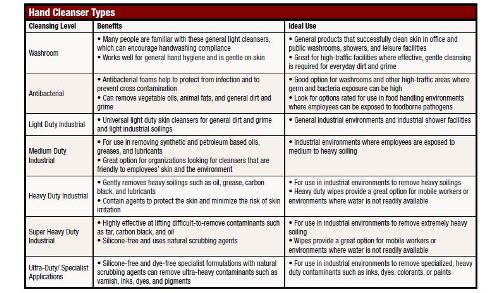
Safer Soap: A Look at Harmful Ingredients Found in Hand Cleansers
According to the Centers for Disease Control and Prevention, up to 40 percent of workers will suffer from occupational dermatitis at some point in their working lives.
People often read food labels to ensure a product they're consuming doesn't contain harmful ingredients such as preservatives, trans-fats, and artificial sweeteners. But, have you ever looked at the ingredients in your hand soap? If you're using an industrial hand cleanser, the label likely lists petroleum distillates as an ingredient. Petroleum distillates are hydrocarbon solvents produced from crude oil and include mineral spirits, kerosene, white spirits, naphtha, and Stoddard solvents. These solvents are produced in oil refineries at the same time as automobile fuel, heating oil, and chemical feedstocks.
Many industrial cleansers use them for the removal of heavy oil and grease, tar, and waxes, meaning you could be washing your hands with them.
Scary Side Effects
Petroleum distillates can have a negative effect on the body if they come in contact with the skin. Short-term exposure can cause skin irritation, but the effects from long-term exposure are even scarier. Prolonged exposure to petroleum distillates is known to cause skin drying or cracking, a condition known as dermatitis. This occurs because the solvents defat pathways around the skin cells, causing inflammation and skin dehydration. Some manufacturers even place warning labels on their products, prompting users to use caution. For example, in 2001, the Zep Manufacturing Company issued a warning regarding its liquid hand cleanser, product 0925, which stated, "Skin which is repeatedly defatted by contact with this product may be more susceptible to irritation, infection or dermatitis."1
In addition to contact dermatitis, petroleum distillates are often contaminated with carcinogens which are absorbed through the skin, potentially leading to harmful levels of toxins in the body. In fact, the European Union banned certain petroleum distillates in cosmetics and personal care products due to concern surrounding these possible human carcinogens.2
Problems with Pumice
Grit is often added to industrial hand cleansers to help remove substances like oil, dirt, and grime. However, there are a number of scrubbers such as pumice and sand that can cause micro-abrasions, or tears, in the skin. Pumice, a natural volcanic rock that consists of rough volcanic glass, is used in construction, housekeeping, polishes, erasers and beauty salons as an abrasive agent. Without a doubt, this common ingredient does its job in these workplace environments to remove contaminants from objects. However, using pumice on your hands will remove the skin, and most people can’t afford further damage to their hands.
There are better scrubbing agents available such as corn meal, ground olive pit or walnut shell. These scrubbers are natural and act as the ideal ingredients to gently yet effectively cleanse the skin. Furthermore, there are environmental impacts to using pumice in hand cleansers. In comparison to pumice, shown to settle in ducts and pipes causing blockages, natural scrubbing agents like corn meal, olive pit or walnut shell are easily rinsed away, not prone to swelling, and will therefore not cause plumbing blockage.
Damage from Dermatitis
In addition to the physical impact dermatitis can have on a person, it can also create a financial burden. According to the Centers for Disease Control and Prevention (CDC), up to 40 percent of workers will suffer from occupational dermatitis at some point in their working lives. Dermatitis can potentially become a financial burden to the employee, as well as the employer. According to the U.S. Bureau of Labor Statistics (BLS), 50 percent of all working time lost to industrial illness is due to dermatitis. Just one case of occupational dermatitis can cost an employer approximately $3,500 in workers' compensation claims, and an average disability of 23.9 days, according to the Journal of the American Medical Association. As with all occupational disease, prevention is the key, and with most cases of occupational dermatitis, prevention entails minimizing or eliminating skin contact with chemicals or other unhealthy, damaging ingredients to help prevent the disease.
Healthy Alternatives
Just like there are healthy ingredients used as substitutes in recipes, there are also alternatives when it comes to hand soaps. It’s important to embrace a product that takes into consideration the impact it has on hands, yet is still powerful and effective enough for the job. Low-solvent and solvent-free cleansers are a safer option than those containing petroleum solvents. Bio-scrubbers such as walnut shells, corn meal, and olive pit are effective without stripping or causing damage to the skin.
Your Guide to Choosing the Right Cleanser and Dispenser
Once your team learns more about prevention, pick the best-suited hand cleanser and dispensing system. Below is a quick reference guide that will keep your crew clean and compliant.

The appropriate products should be available and accessible to workers where and when they are required. Creams should be located in key areas such as changing rooms, work area entrances, washrooms and hand washing stations.
Soap is designed to clean hands, not harm them. However, the soap you're using could be doing just that. Employers and facility managers have a legal responsibility to ensure that they provide a safe working environment for their employees. Addressing hand hygiene is an important part of this. The type of hand cleanser selected is vitally important to skin health. A common misconception is that a hand cleanser's performance is measured by its ability to clean hands aggressively. In actuality, most cleansers unnecessarily far surpass the user's actual cleansing power requirements. By selecting an effective product that does not contain skin damaging ingredients, you, in turn, can wash your hands of the risk and damage of dermatitis.
References
1. http://www.orcbs.msu.edu/msds/111203_HMB_002_ZEPIDREDAEROSOL.pdf
2. http://eur-lex.europa.eu/LexUriServ/LexUriServ.do?uri=CONSLEG:1976L0768:20100301:en:PDF
This article originally appeared in the June 2017 issue of Occupational Health & Safety.